1. You’re walking too slowly
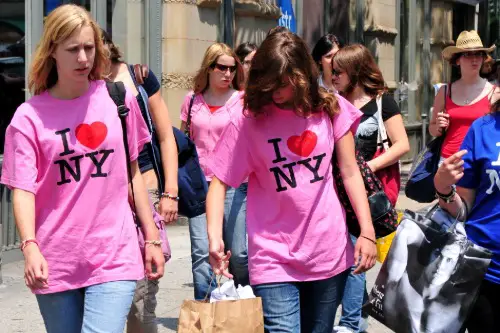
One of the classic signs of being a tourist is walking too slowly, especially in busy urban areas. When you’re new to a city, everything is new and exciting, so you tend to linger a little longer, taking in the sights, reading street signs, and adjusting to the hustle and bustle of the environment. But for locals, it’s all about efficiency. They know where they’re going, and they’ve mastered the art of weaving through crowds without slowing down. According to a study published in The New York Times, Americans walk faster than people in most countries, so the contrast is stark.
The result is that tourists often find themselves inadvertently blocking sidewalks or stopping in the middle of busy pedestrian traffic. This can be especially noticeable in fast-paced cities like New York or San Francisco, where people are often in a rush to get somewhere. While tourists are snapping pictures or admiring the architecture, locals are navigating the sidewalks with a determined pace, rarely pausing to take in their surroundings. If you’ve ever stood behind a tourist who’s moving at a pace that feels like a leisurely stroll through a park, you’ve probably sighed in exasperation, realizing they’re not in a hurry to get anywhere.
2. You’re not quite sure about the public transport system
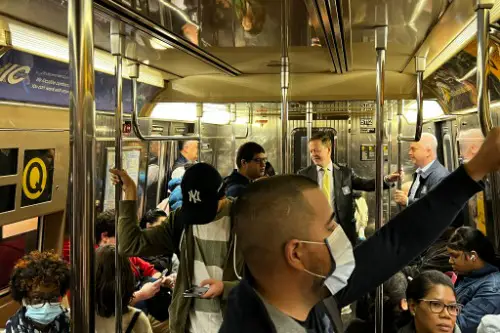
While tourists can easily get the hang of New York’s subway or the buses in San Francisco, there’s a certain level of confusion that often comes with navigating public transportation for the first time in America. Locals are quick to hop on and off without thinking twice, knowing exactly what stops to make, where to transfer, and which route will get them to their destination in the fastest time possible. But for a tourist, the system can be daunting, especially those coming from cities like London, according to The Guardian, as they are used to a very specific kind of public transportation.
One of the telltale signs that you’re a tourist is standing at the ticket machine, trying to figure out which pass to buy. Locals know exactly which type of ticket they need, and they swipe through the turnstiles without hesitation. But tourists often get caught up in the language of the transit system, reading the signs over and over and sometimes even asking fellow passengers which train to take. In some cities, tourists might be seen standing in front of a bus map, trying to make sense of the routes while everyone else walks right past them. The unfamiliarity with the schedule and stops can be a clear giveaway that someone is a tourist.
3. You’re always talking about tipping

In America, tipping is deeply ingrained in the culture, especially in sectors like hospitality, restaurants, and transportation. However, for tourists, it can be confusing because tipping expectations can vary drastically from what they’re used to in their home countries, and according to The Guardian, it can be quite annoying. A visitor from Europe might not understand the 15-20% standard for restaurant service, while a traveler from Japan could find it odd to tip anyone at all. So, it’s no surprise that tourists often find themselves talking about tipping.
They might ask waiters, “How much should I leave?” or seek reassurance from other tourists: “Is this a good tip, or should I give more?” There’s an uncertainty around the process that locals don’t have because they’ve grown accustomed to the system. Americans generally understand that tipping is expected for good service, but tourists might feel awkward or unsure about how much is enough. This anxiety often leads them to discuss tips loudly in restaurants, which can be a dead giveaway that they’re new to the country. Some tourists also overcompensate by tipping excessively, out of fear of being perceived as cheap, which further distinguishes them from the locals who are used to the more standard rates.
4. You’re amazed by free refills

It’s one of the most common things tourists notice when dining out in America: free refills. In many parts of the world, ordering a drink usually means paying for each one, but in the U.S., particularly in casual restaurants, refills for soda, coffee, and iced tea are often free. Tourists frequently express their amazement, asking, “Wait, it’s free?” or even looking around to see if everyone else is getting the same treatment, The New Yorker shares.
This cultural difference stands out because Americans don’t think twice about it. In fact, they’re so used to it that it’s not even a topic of conversation anymore. But when a tourist orders a soda and then finds out that they can get as many refills as they want without extra charge, their shock and excitement are immediately noticeable. It’s often accompanied by an audible “wow,” as they wonder how much they’ve been missing out on in their own countries where drinks usually come with a cost for every refill.
5. You’re fascinated by the size of the portions at restaurants
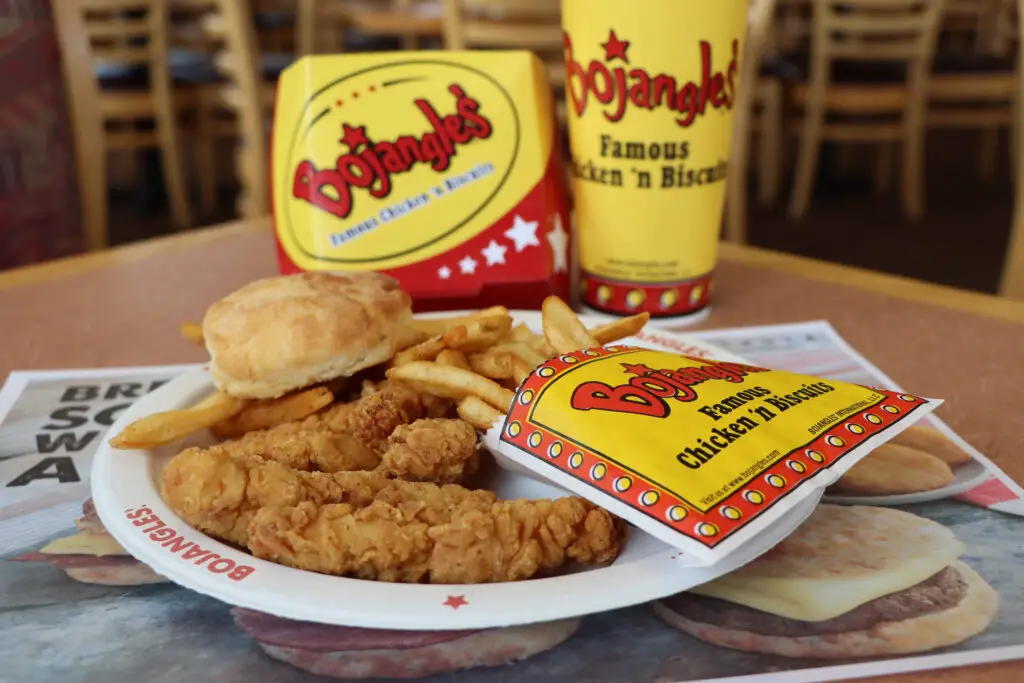
One of the biggest surprises for tourists in America is the sheer size of food portions. In many parts of the U.S., portion sizes are much larger than in other countries. Whether it’s a giant hamburger, an overflowing plate of pasta, or a mountain of pancakes, the American portions can be overwhelming for tourists, and as The Mirror explains, the tiny portions abroad can be unsatisfying for Americans. And while locals have gotten used to it, tourists are often left in awe, staring at the plate in disbelief.
It’s common for tourists to comment on the size of the meals, asking waitstaff if they’re sure that’s the “regular” size or saying something like, “Wow, this is huge!” It’s clear that they’re not used to getting so much food on one plate, and this fascination with portion size marks them as someone who isn’t yet familiar with the American dining experience. The amount of food in some restaurants could feed a small family, and it’s always a bit surprising for tourists to find out that they’re expected to eat it all or take leftovers home in a doggie bag. Locals are generally more accustomed to portion sizes and are less likely to express surprise when their meal arrives.
6. You’re constantly using your phone for directions

In the U.S., relying on smartphones for directions is practically a way of life. For tourists, this becomes even more apparent because they often don’t know their way around the city. It’s common to see someone standing on the corner of a busy intersection, peering down at their phone screen, swiping to zoom in or out, trying to pinpoint the exact route to take. It’s not just about navigating the streets but also about feeling a little overwhelmed by unfamiliar surroundings. Locals might pull out their phones once in a while, but for tourists, it’s a constant companion.
What gives it away is the frequency with which tourists use their phones. A local might only check directions once or twice when walking somewhere, relying more on their knowledge of streets and landmarks. In contrast, a tourist can be seen checking their phone every few minutes, often reorienting themselves and missing turns. This is especially true in big cities like New York or Los Angeles, where street names can be confusing or repetitive. The tourist’s habit of standing in the middle of the sidewalk, intensely focused on their phone, marks them as someone who’s still adjusting to the city’s rhythm and layout.
7. You’re always looking up at buildings

The first time you visit a big American city like New York or Chicago, you can’t help but marvel at the towering skyscrapers. They’re so tall that you might feel like you’ve entered a different world entirely, one where the buildings seem to scrape the sky. Tourists often spend a lot of time staring up at these architectural giants, especially in places like Times Square, where the sheer scale of the buildings combined with flashy advertisements is overwhelming. Locals, on the other hand, have seen it all before. They go about their day with their heads down, focused on their tasks.
The distinctive behavior of tourists is their tendency to gawk—really, just stare—in awe. They’re likely to take photo after photo, adjusting their angle, trying to capture the perfect shot. Whether it’s the Chrysler Building or the Golden Gate Bridge, there’s a sense of wonder that tourists experience, but it’s an experience that many locals have long since stopped noticing. While locals might glance up to check the weather or find a specific spot, they won’t be as absorbed in the surroundings as someone unfamiliar with the area. It’s the classic tourist move to walk around with your neck craned back, taking in all the details of a massive building while others are walking briskly by without a second glance.
8. You’re overly enthusiastic about the food
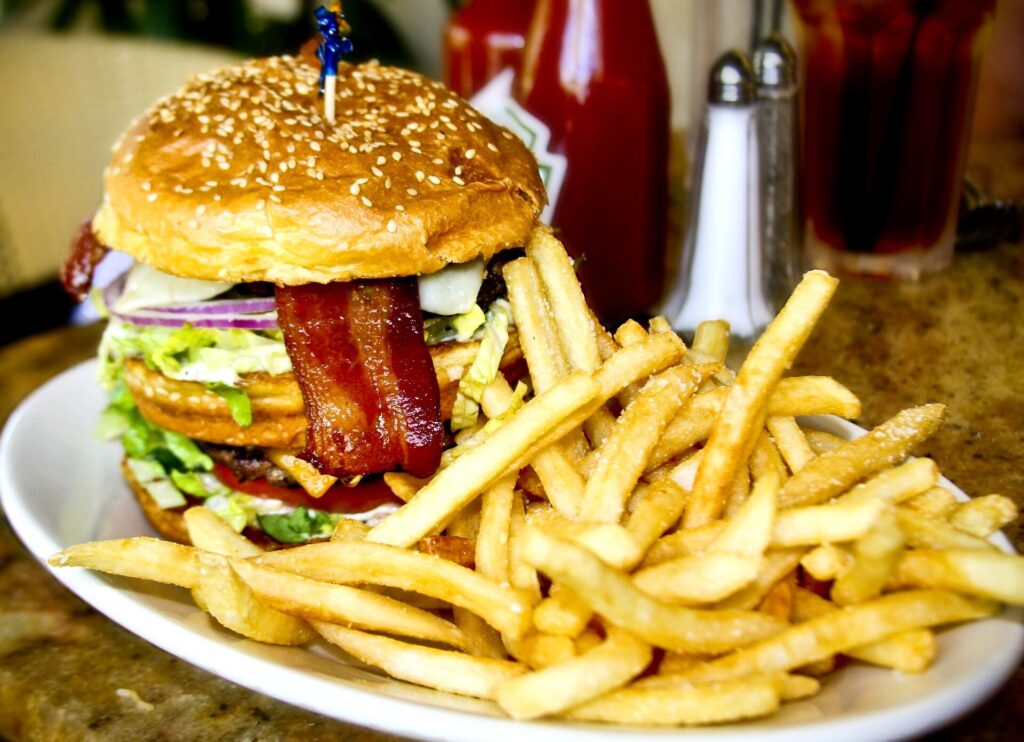
Food in America is diverse, and tourists often get excited about trying iconic dishes like pizza in New York, barbecue in Texas, or a California burrito. However, locals are often much less enthusiastic about the foods that define their region because they eat them regularly. For tourists, though, it’s an experience—they want to try everything and often talk about it at length, excitedly discussing how it compares to food back home.
It’s the kind of thing you hear in every restaurant, “This pizza is the best I’ve ever had!” or “I can’t believe how big these portions are!” Americans may enjoy a good meal, but they’ve learned to take it for granted. Tourists, on the other hand, are often so focused on the experience of eating American food that it becomes the central highlight of their visit. Their constant chatter about the food, taking photos of every meal, and showing wide-eyed amazement at the portions or flavors make it clear that they’re experiencing something new and exciting.
9. You’re constantly taking photos of everything
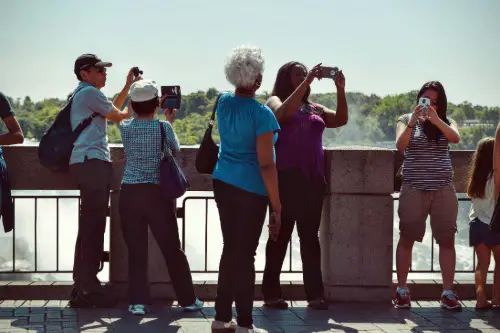
It’s almost impossible to spot a tourist in America without seeing them take photos. From the Grand Canyon to the Hollywood Walk of Fame, tourists feel compelled to document every single moment. It’s not just about taking one quick snapshot; it’s about capturing the experience from every possible angle. If you’ve ever seen someone in front of a famous landmark, holding up their phone at arm’s length for the perfect selfie, you’ll know exactly what I mean.
What really sets tourists apart, though, is their obsession with the photo. Locals might take a quick picture or two, but they’re much more likely to just enjoy the experience without feeling the need to document everything. A tourist, on the other hand, might take a dozen photos from different angles, adjust their camera settings, and worry about how they look in each shot. The tourist’s camera roll quickly fills up with identical shots of the same monument, while locals are busy living their lives, occasionally snapping a photo when something particularly special catches their eye.
10. You’re wearing a fanny pack or a backpack
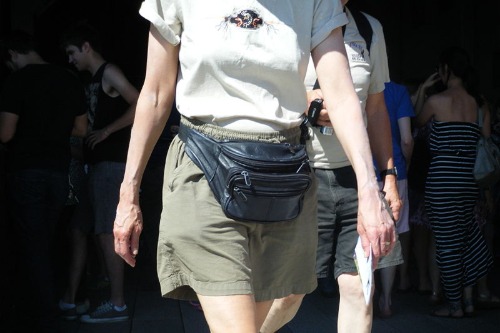
It may be a bit of a stereotype, but there’s no denying that tourists are often spotted wearing fanny packs or overstuffed backpacks as they traverse American cities. These accessories aren’t just convenient; they’re also a sign that someone is traveling light and carrying around the essentials—maps, water bottles, snacks, and maybe even a camera. While some American locals still wear these items, they’re mostly relegated to outdoor activities or theme parks, not everyday city life.
Fanny packs, in particular, scream “tourist” because they’re not as common in the U.S. fashion scene anymore. You’ll usually see locals with more stylish or practical bags, like crossbody purses or simple satchels. But a tourist with a fanny pack, especially one loaded with travel necessities, immediately gives off the impression of someone who’s on vacation and exploring the city for the first time. Similarly, overstuffed backpacks indicate that the person is carrying more than just their essentials, often as a result of trying to pack everything they might need during their sightseeing adventures.
11. You’re constantly saying “Excuse me” and apologizing

While American culture tends to lean toward politeness and “excuse me” can be heard frequently in crowded spaces, tourists tend to overuse it. Whether they’re trying to navigate a busy subway or politely ask for directions, tourists often say “excuse me” with a frequency that stands out. Locals, on the other hand, are more comfortable with the environment and are able to make their way through it with less need to constantly apologize or excuse themselves.
This excessive politeness often comes from an eagerness to fit in, but it’s something that stands out to anyone familiar with the area. Tourists may feel like they’re intruding on other people’s space, which is why they’ll apologize even for things like bumping into someone lightly or standing in the middle of the sidewalk while looking at their map. The level of discomfort they have around this makes it clear they’re not yet accustomed to the fast pace and bustling nature of American cities, where most people move through crowds with purpose and confidence.
12. You’re taking your time at the ATM
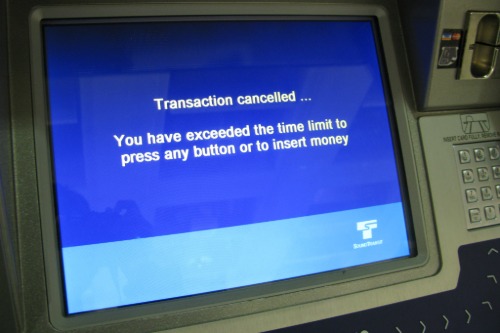
In many parts of the world, ATMs are just a quick stop—withdraw the cash, grab the receipt, and go. But in America, tourists often seem to linger longer than necessary at the ATM. It’s not that they’re unfamiliar with using ATMs, but they may be struggling with the specific features of the American banking system, like withdrawing larger sums of cash, choosing between debit and credit, or selecting the correct account type.
What gives it away is the hesitation and extra steps involved in their transactions. Locals typically zip through the process, entering their pin and withdrawing cash with speed. For tourists, the combination of unfamiliarity with the bank network, as well as language barriers or security concerns, makes them look unsure and cautious. You might even see them checking their balance multiple times or opting for smaller withdrawals to avoid making a mistake. It’s a simple thing, but for anyone who lives in the U.S., it’s easy to spot the tourist at the ATM who is still getting the hang of how things work.
13. You’re stopping to take pictures of road signs

If you’ve ever seen someone stop and take a picture of a road sign, chances are they were a tourist. Whether it’s a quirky street name or a highway marker, tourists tend to photograph road signs in a way that locals never would. Americans are used to seeing the same signs daily, and they often pass them without giving them a second thought. However, for tourists, the excitement of encountering something new—whether it’s a sign that’s different from their home country or something uniquely American, like a “Y’all” sign in the South—makes them eager to capture the moment.
This can be especially obvious on iconic highways or in states where road signs might have different styles or formats. Tourists are often seen standing on the side of the road or pulling over on highways just to take a snapshot of something they think is unique. Locals may find it funny or strange, but to tourists, these seemingly insignificant signs represent something new and worth remembering.
14. You’re always asking for a “restroom” and not a “bathroom”
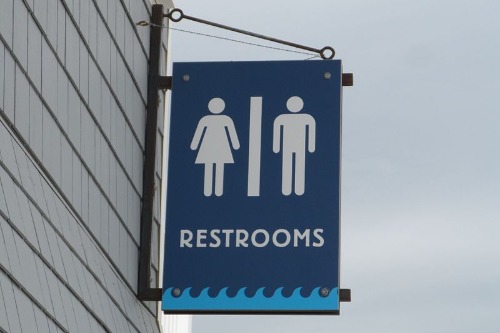
In most countries outside the U.S., the term “bathroom” is the standard term used for public restrooms. However, in America, the word “restroom” is far more common. This linguistic difference stands out because tourists often ask for a “bathroom,” which might be met with confused looks from locals, especially in a setting like a restaurant, where asking for a “restroom” is the norm.
What’s interesting is how readily this difference becomes apparent. When tourists use the word “bathroom,” it’s often a quick giveaway that they’re not American. Locals may even gently correct them, saying, “Oh, you mean the restroom?” and that’s when the tourist realizes that even something as basic as terminology can mark them as an outsider. Though it’s not a big deal, it’s a simple slip-up that’s easily noticeable.
15. You’re wearing sandals with socks
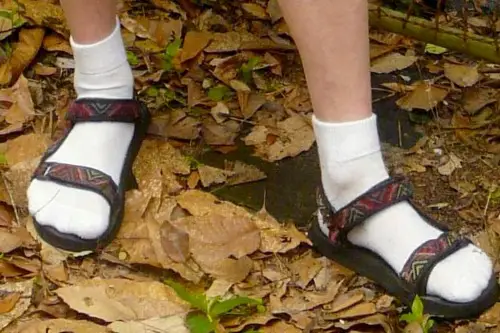
While this may sound like a stereotype, there’s some truth to it. Americans generally avoid the “sandals and socks” look, as it’s often seen as a fashion faux pas in many parts of the country. However, it’s not uncommon for tourists to sport this look, especially during the summer months. It’s practical, especially if they’re doing a lot of walking or sightseeing, but it also signals to locals that the person is unfamiliar with American fashion norms.
Americans tend to view sandals without socks as the default when it comes to warm weather footwear, and they might raise an eyebrow when they spot someone wearing socks with sandals. To a tourist, it’s a way to stay comfortable, but to locals, it’s a clear indicator that the person might be from overseas. This simple fashion choice might make them stand out in a crowd of people who are typically dressed in sneakers, flip-flops, or stylish sandals without socks.


